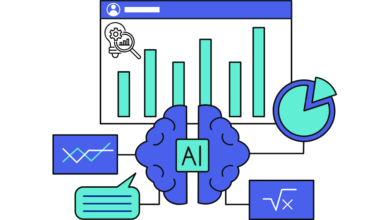Today, Artificial Intelligence is everywhere. From startups to established enterprises and tech giants, AI is accelerating across industries.
However, many organisations still remain fearful of the unknown, and yet this shouldn’t be the case. Using new technologies can keep you ahead of competition, provide better solutions to your customers through actionable data insights and help you maintain a leading position in the market. But as always, with new technologies come new challenges, leading to only 53 percent of AI projects making it into production, according to Gartner.
AI is a pioneering form of technology, and as a result it can be complex to develop and challenging to upscale. We recently held a roundtable with European business leaders to understand some of the challenges they face when implementing AI, and below we’ll discuss their top concerns.
1. Attracting Top Talent
Given the complicated nature of AI, it requires the industry’s top talent to be able to understand and effectively optimise the technology within any given organisation.
Elisabeth Rochman, Director of Innovation at Xerox, recently completed a postgraduate degree in AI. Although she has an engineering background, AI is “a completely different space” from what she studied. Studying new technologies means employers have the knowledge needed to recruit, like knowing which questions to ask during recruitment to get the right team in place.
It’s also important to note that most people probably aren’t experts in everything – after all, a lot of the technology hasn’t been around for that long. When working on rapidly developing, cutting-edge technology, it becomes hard to find people with specific experience in those areas. Recruiting for roles working with new technology needs an open mindset, so that hiring managers can create a team of skilled people that can work together to develop solutions and capabilities that drive the business forward.
Retention is just as important as recruitment in the tech world. Supporting employees with the resources they need, such as regular training, alongside providing them engaging opportunities to work on cutting-edge innovations like conversational AI, autonomous vehicles and fundamental AI research are key to retention. It’s down to the company to deliver this and keep the employee feeling fulfilled and inspired to produce their best work.
2. Tackling Local Data Security Regulations Hurdles
Data regulations vary from one country to another and are changing every day. The time required to stay ahead of this and gather data insights effectively requires a full-time role for global companies. Having work that is dictated by regulations that change frequently and differ by country, is “a big hurdle”, according to Rochman. Vjekoslav Bonic, Head of Advanced Analytics & Artificial Intelligence at Raiffeisen Bank adds that the European GDPR legislation and the banking sector are both very protective. This strict control means businesses aren’t able to implement AI solutions at the level they want, because they’re unable to get the data required to do so.
While regulations are essential to protect consumer rights, they should still work for businesses looking to leverage the data they have worked hard to collect. Raveendra Bharadwaj, Chief Data Architect at HSBC explains “Secrecy is the biggest requirement we have. We can’t even share data across our own organisation.” On top of this, data is collected in different ways across different regions, which means when the data is consolidated, it has to be mapped and cleansed. That’s a lot of groundwork to get to the anonymous data needed for analysis.
External regulations, internal governance and organisational structure can all significantly slow down the time it takes to deliver data. Federated learning, a technique most commonly used in the medical industry, is knocking down barriers to anonymised data and rapidly increasing the usability of secure data. It decentralises deep learning by removing the need to pool data into a single location. Instead, the model is trained in multiple iterations at different sites. This can be especially useful for global organisations with data sources around the world, as it opens up the possibility for teams to build larger, more diverse datasets for training their AI algorithms.
3. Optimising data sources
If it takes analysts weeks or even months to get access to anonymous data, they can find themselves in a place where they’re trying to solve last year’s problem, not tomorrow’s. The hours spent requesting and accessing anonymous data, often means its redundant before it can even be considered.
As Debbie Evans, Group Data Protection Officer at Rentokil Initial puts it rather aptly, “things seem to move slowly, but ideas move a lot faster.”
Federated learning can play a key role here. Companies and research institutions developing AI models are typically limited by the data available to them. To gather enough training data for a robust, generalisable model, most organisations would need to pool data with their peers. But in many cases, data privacy regulations limit the ability to directly share data — like patient medical records or proprietary datasets — on a common supercomputer or cloud server. That’s where federated learning comes in. Privacy-preserving federated learning techniques can enable the creation of robust AI models that work well across organisations, even in industries constrained by confidential or sparse data.
4. Putting the AI into ‘Business Strategy’
Arguably the most important part of implementing AI is integrating and optimising it for your business strategy.
The success that comes from using AI is highest when businesses integrate it fully into their strategy, rather than creating an AI solution and retro-fitting it to make it work for your business. Considering a longer-term approach is one way to get senior management on board. Understanding where the business needs to be in one to five years, and what is needed to get there, can highlight the importance of a long-term strategy.
Ali Naseer, IT Director at Gilead gets emails from “every AI company in the world saying, “We will sort out your problem!”.” But without understanding the business’s strategy — how could they possibly know what problems need to be solved?
An AI solution isn’t a bolt-on to the IT department within an organisation. It should be used to enhance opportunities business-wide and implemented collaboratively across both IT and the senior leadership teams.
Investing in AI can provide an improved customer service and internal operations, enabling businesses to reduce costs while increasing outputs. With the right investments and strategic implementation, the benefits of AI on business profits and performance can be tenfold.
5. Data Center Decisions: On-Premises vs Cloud
Data centers can play a pivotal role in solving some of the world’s most important challenges. There are two options for a data center’s location: on-premises or in the cloud. Both have their advantages and disadvantages, depending on the business’ requirements.
Whilst on-premises data centers offer the benefit of quick data accessibility, it’s debated whether the cloud is safe enough, and meets the rigorous data regulations that a global organisation might face. Combining data sets in the cloud, for example, is a good work around for some regions, but not all. Getting data to the cloud at scale is a challenge, according to Mark Sibson, CTO of Data and Messaging at HSBC, particularly due to international regulations. Even after following those regulations, he added it can take “six to nine months” to get access to the data. On-premises data centers also lack the same level of algorithm training that the cloud provides. The strength of an AI algorithm comes from the amount of data it is fed, meaning a cloud-based algorithm with access to a wider range of data is more likely to be better trained. Rochman gives an example of detecting forgeries, where the greater the exposure to forgeries, the better an algorithm will become at detecting them. An on-premises algorithm with access to less data makes forgery harder to detect, meaning a less effective solution in comparison to the cloud.
As AI technology advances, the processes and costs are improving, giving organisations more opportunity to harness their data in the way that works for them. The combination of the democratisation of AI as well as better access to AI models and resources have all made this simpler. AI models for example, often don’t have to be built from scratch. Leading AI organisations like NVIDIA or Google have built huge catalogs of models that can be tailored to specific business needs and their own data.
New Technology equals New Solutions
Making AI work for your organisation isn’t easy or straightforward. That being said, we’re not even 10 years into the invention of AI, and the potential this technology holds is enormous. While it’s already accelerating industries globally, there is still plenty of opportunity for any business to get involved.
Building AI into the business strategy, having a team that can create an infrastructure that works to meet the needs of the business, and finding the right way to use the data available are the key building blocks to implementing AI.




